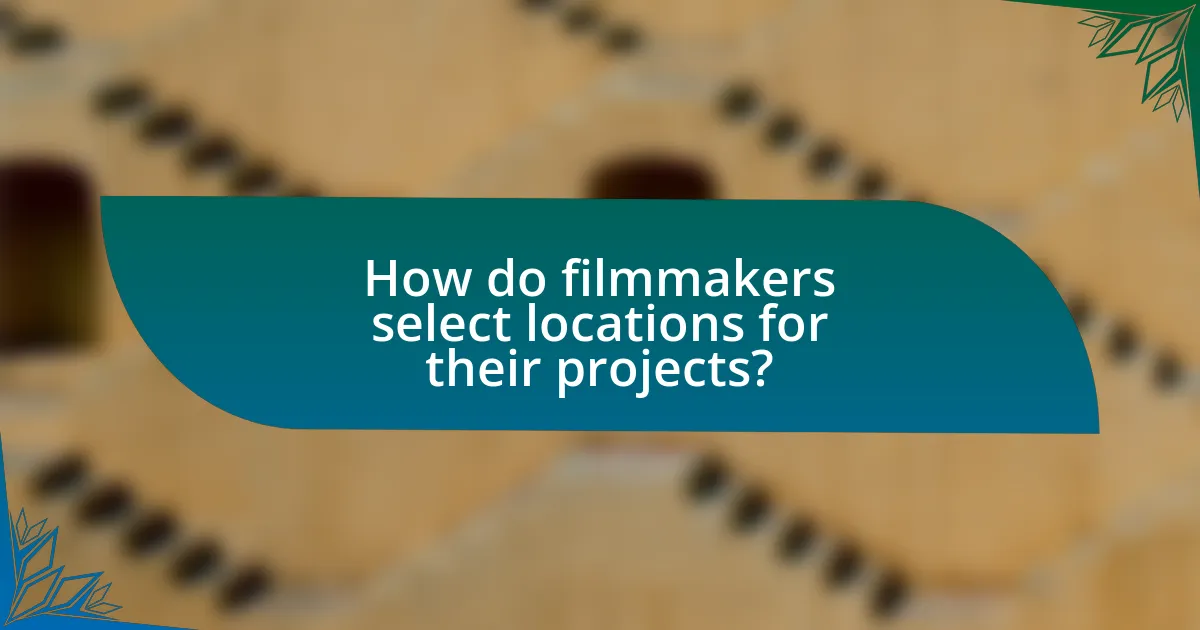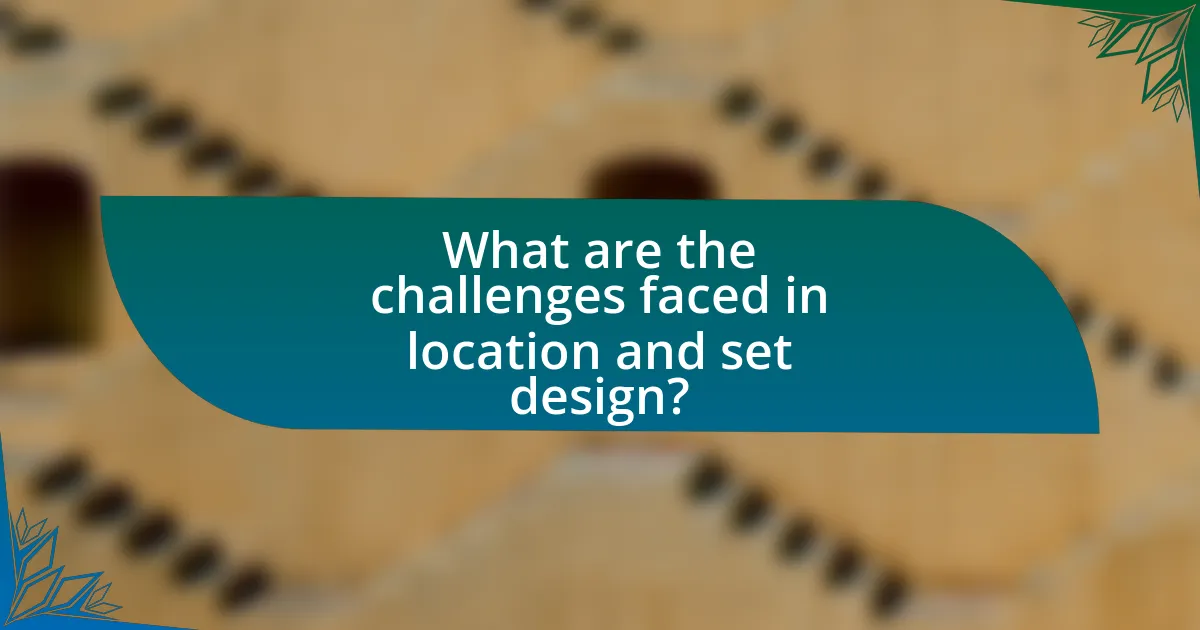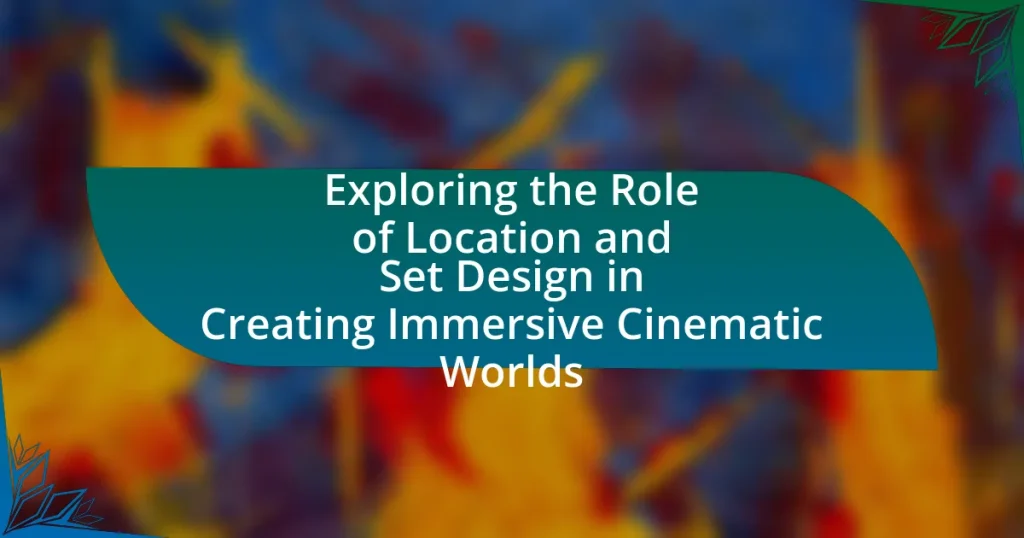The article explores the critical role of location and set design in creating immersive cinematic worlds. It highlights how the choice of locations enhances narrative authenticity and emotional engagement, while set design reflects character development and thematic elements. Key components such as geographical features, cultural context, and historical significance are discussed, along with the impact of color schemes and textures on mood. The article also addresses the challenges filmmakers face in location scouting and set design, emphasizing the importance of collaboration and thorough research in achieving effective visual storytelling.

What is the significance of location and set design in cinema?
Location and set design are crucial in cinema as they establish the visual context and emotional tone of a film. The choice of location influences the narrative by providing authenticity and grounding the story in a specific cultural or historical setting. For instance, the use of real locations, such as the streets of New York in “Her” or the deserts of Tunisia in “Star Wars,” enhances the believability of the film’s world. Set design further complements this by creating environments that reflect the characters’ inner lives and the film’s themes, as seen in the meticulously crafted sets of “Blade Runner,” which evoke a dystopian atmosphere. Together, these elements shape audience perception and engagement, making them integral to the storytelling process in cinema.
How do location and set design contribute to storytelling in films?
Location and set design significantly enhance storytelling in films by establishing the visual context and emotional tone of the narrative. Locations provide a backdrop that reflects the characters’ circumstances and the themes of the story; for instance, a dilapidated urban setting can evoke feelings of despair, while a vibrant countryside can symbolize hope and freedom. Set design further enriches this by incorporating specific details that reveal character traits and plot elements, such as a cluttered workspace indicating a character’s chaotic life or a minimalist environment suggesting emotional detachment.
Research shows that viewers often subconsciously interpret visual cues from locations and set designs, which can influence their emotional responses and understanding of the story. For example, in “The Grand Budapest Hotel,” the meticulously crafted sets and distinct color palettes not only create a whimsical atmosphere but also reflect the film’s themes of nostalgia and loss. Thus, both location and set design are integral to immersing the audience in the film’s world and enhancing the overall narrative experience.
What elements of location enhance the narrative experience?
Elements of location that enhance the narrative experience include geographical features, cultural context, and historical significance. Geographical features, such as mountains, rivers, or urban landscapes, create a visual backdrop that influences the mood and tone of the story. Cultural context provides depth by reflecting the traditions, values, and social dynamics of the setting, which can shape character motivations and conflicts. Historical significance adds layers to the narrative, as locations tied to specific events or eras can evoke emotional responses and inform character development. For example, films set in historically rich locations, like “Schindler’s List” in World War II-era Poland, utilize the setting to amplify the emotional weight of the narrative.
How does set design influence character development?
Set design significantly influences character development by establishing the environment in which characters exist, thereby shaping their behaviors, motivations, and interactions. For instance, a character’s living space can reflect their socioeconomic status, personality traits, and emotional state, which informs the audience’s understanding of that character. Research indicates that visual elements in set design, such as color schemes and spatial arrangements, can evoke specific emotional responses, further enhancing character depth. For example, a cluttered, dimly lit room may suggest a character’s chaotic mental state, while a bright, open space can indicate optimism or freedom. This interplay between set design and character portrayal is crucial in creating a believable and immersive narrative.
Why are authentic locations important for immersive experiences?
Authentic locations are crucial for immersive experiences because they enhance the realism and emotional connection of the audience to the narrative. When a setting reflects genuine cultural, historical, or geographical elements, it allows viewers to suspend disbelief and engage more deeply with the story. For instance, films shot in real locations often achieve higher audience ratings and critical acclaim, as evidenced by the success of movies like “The Lord of the Rings,” which utilized New Zealand’s landscapes to create a believable fantasy world. This connection between authenticity and audience engagement underscores the importance of real locations in crafting compelling cinematic experiences.
What role does cultural context play in location selection?
Cultural context significantly influences location selection by shaping the narrative, aesthetics, and authenticity of cinematic worlds. Filmmakers often choose locations that resonate with the cultural themes and values depicted in their stories, ensuring that the setting enhances the viewer’s understanding and emotional connection. For instance, a film set in Japan may utilize traditional architecture and landscapes to reflect cultural heritage, as seen in movies like “Lost in Translation,” which effectively captures the essence of Tokyo’s urban culture. This alignment between cultural context and location not only enriches the storytelling but also attracts audiences familiar with those cultural nuances, thereby enhancing the film’s overall impact and reception.
How does the choice of location affect audience perception?
The choice of location significantly influences audience perception by shaping the emotional and contextual framework of a narrative. Locations can evoke specific feelings, such as nostalgia or tension, based on their cultural, historical, or geographical significance. For instance, a film set in a bustling urban environment may create a sense of chaos and urgency, while a serene rural setting can evoke tranquility and introspection. Research indicates that viewers often associate particular locations with specific genres or themes, impacting their expectations and engagement with the story. A study by the University of Southern California found that settings can alter viewers’ emotional responses, with familiar locations enhancing relatability and immersion. Thus, the strategic selection of locations is crucial in guiding audience interpretation and emotional engagement in cinematic storytelling.
What are the key components of effective set design?
The key components of effective set design include functionality, aesthetics, and context. Functionality ensures that the set serves the narrative and practical needs of the production, allowing for seamless movement and interaction among actors. Aesthetics involve the visual appeal and style of the set, which should align with the overall tone and theme of the project, enhancing the audience’s emotional engagement. Context refers to the historical, cultural, and geographical accuracy of the set, which grounds the story in a believable reality. These components work together to create an immersive environment that supports storytelling and enhances viewer experience.
How do color schemes and textures impact the mood of a scene?
Color schemes and textures significantly influence the mood of a scene by evoking specific emotional responses and setting the overall tone. For instance, warm colors like reds and oranges can create feelings of warmth and excitement, while cool colors such as blues and greens often evoke calmness or sadness. Textures, such as rough surfaces or smooth finishes, can enhance these emotional cues; a gritty texture may suggest tension or conflict, while a soft texture can imply comfort or serenity. Research in color psychology supports these effects, indicating that colors can trigger emotional reactions based on cultural associations and personal experiences.
What techniques do designers use to create realistic environments?
Designers use techniques such as detailed texture mapping, realistic lighting, and spatial composition to create realistic environments. Texture mapping involves applying high-resolution images to 3D models, enhancing surface detail and realism. Realistic lighting techniques, including global illumination and shadow mapping, simulate how light interacts with surfaces, creating depth and atmosphere. Spatial composition focuses on the arrangement of elements within a scene to guide the viewer’s eye and create a believable space. These methods are supported by industry practices, such as the use of photogrammetry, which captures real-world textures and dimensions, further enhancing the authenticity of the environments.

How do filmmakers select locations for their projects?
Filmmakers select locations for their projects by evaluating factors such as the script’s requirements, visual aesthetics, logistical considerations, and budget constraints. The script often dictates the type of environment needed, whether urban, rural, or fantastical, guiding the search for suitable locations. Visual aesthetics play a crucial role, as filmmakers seek locations that enhance the story’s mood and themes, often using scouting techniques to assess the visual appeal and suitability of potential sites. Logistical considerations, including accessibility, safety, and available resources, are also critical, as they can significantly impact the production process. Budget constraints further influence location selection, as filmmakers must balance the desired setting with the financial resources available for location fees, travel, and accommodations.
What factors influence the decision-making process for location scouting?
The decision-making process for location scouting is influenced by several key factors, including the script requirements, budget constraints, logistical considerations, and aesthetic appeal. Script requirements dictate the specific settings needed to authentically portray the story, while budget constraints limit the options available based on costs associated with travel, permits, and site preparation. Logistical considerations encompass accessibility, availability of resources, and local regulations that may impact filming. Aesthetic appeal involves the visual characteristics of a location, which must align with the film’s artistic vision to create an immersive experience. These factors collectively guide filmmakers in selecting locations that enhance the narrative and production quality.
How do budget constraints affect location choices?
Budget constraints significantly limit location choices in film production by restricting the available options to those that fit within financial limits. Productions with tighter budgets often prioritize locations that are less expensive to rent or that require minimal logistical costs, such as travel and accommodation for cast and crew. For instance, a study by the Producers Guild of America indicates that location costs can account for up to 30% of a film’s budget, compelling filmmakers to select nearby or less popular sites to reduce expenses. Consequently, budget constraints directly influence the creative decisions regarding location, often leading to compromises in the visual and thematic elements of the film.
What role does accessibility play in location selection?
Accessibility is crucial in location selection as it determines how easily cast, crew, and equipment can reach the site. Locations that are easily accessible reduce logistical challenges, enhance production efficiency, and minimize costs associated with transportation. For instance, a study by the American Film Institute highlights that productions often favor locations within a certain distance from major transportation hubs to streamline operations. This preference for accessible sites ensures that time and resources are optimized, ultimately contributing to the success of the cinematic project.
How do filmmakers collaborate with location managers?
Filmmakers collaborate with location managers by engaging them early in the pre-production process to identify and secure suitable filming locations that align with the film’s vision. This collaboration involves location managers presenting various site options, negotiating permits, and ensuring logistical feasibility, which allows filmmakers to focus on creative aspects while relying on the location manager’s expertise in local regulations and resources. For instance, in the production of “La La Land,” the location manager played a crucial role in scouting iconic Los Angeles sites that enhanced the film’s narrative, demonstrating the importance of this partnership in achieving an authentic cinematic experience.
What are the responsibilities of a location manager?
A location manager is responsible for finding, securing, and managing locations for film and television productions. This role includes scouting potential sites, negotiating contracts with property owners, and ensuring that the locations meet the production’s logistical and aesthetic needs. Additionally, the location manager coordinates with various departments, such as art and camera, to ensure that the chosen sites align with the creative vision of the project. They also handle permits and legal requirements, ensuring compliance with local regulations. The effectiveness of a location manager is crucial, as the right location can significantly enhance the storytelling and visual impact of a film or show.
How does communication between departments enhance location use?
Communication between departments enhances location use by facilitating collaboration and ensuring that all teams are aligned on the vision and requirements of a project. When departments such as production design, cinematography, and location management communicate effectively, they can share insights about the specific needs of each scene, leading to more informed decisions about location selection. For instance, a well-coordinated dialogue can reveal how lighting conditions at a location will affect the visual storytelling, allowing for adjustments in set design or shooting schedules. This synergy not only optimizes the use of locations but also maximizes the overall impact of the cinematic experience, as evidenced by successful films that have utilized integrated departmental communication to create cohesive and immersive environments.

What are the challenges faced in location and set design?
The challenges faced in location and set design include budget constraints, logistical issues, and the need for creative alignment with the narrative. Budget constraints often limit the scope of available locations and materials, impacting the overall aesthetic and functionality of the set. Logistical issues, such as accessibility and permits, can complicate the selection and preparation of locations, leading to delays and increased costs. Additionally, ensuring that the design aligns with the film’s narrative and visual style requires effective collaboration among directors, production designers, and other creative team members, which can be challenging to coordinate.
What common obstacles do filmmakers encounter during location shoots?
Filmmakers commonly encounter obstacles such as weather conditions, logistical challenges, and location permissions during location shoots. Weather can disrupt shooting schedules, as rain or extreme temperatures may hinder outdoor filming. Logistical challenges include transporting equipment and crew to remote locations, which can be time-consuming and costly. Additionally, obtaining necessary permits and permissions from local authorities or property owners can delay production, as regulations vary significantly by location. These factors collectively impact the efficiency and success of location shoots in filmmaking.
How do weather conditions impact filming on location?
Weather conditions significantly impact filming on location by affecting visibility, sound quality, and the overall aesthetic of the scene. For instance, rain can create a moody atmosphere but may also hinder equipment functionality and actor performance. Extreme temperatures can lead to discomfort for the cast and crew, potentially causing delays. Additionally, natural light variations due to cloud cover or sunlight can alter the visual quality of shots, necessitating adjustments in camera settings or lighting equipment. Historical data shows that films shot in adverse weather conditions often require more time and resources to achieve desired results, as seen in productions like “The Revenant,” where weather played a crucial role in both the narrative and logistical challenges faced during filming.
What logistical issues arise from remote locations?
Logistical issues that arise from remote locations include limited access to transportation, difficulties in sourcing materials, and challenges in coordinating crew and equipment. Remote locations often lack adequate infrastructure, which can lead to delays in the delivery of essential supplies and hinder the movement of personnel. For instance, a study by the International Journal of Logistics Management highlights that projects in isolated areas frequently experience increased costs and extended timelines due to these transportation and supply chain constraints. Additionally, the need for specialized equipment to navigate difficult terrains can further complicate logistics, making it essential for production teams to plan meticulously to mitigate these challenges.
How can set designers overcome limitations in studio environments?
Set designers can overcome limitations in studio environments by utilizing innovative techniques such as modular set construction, digital technology, and creative lighting. Modular set construction allows for flexible designs that can be easily reconfigured to suit different scenes, maximizing the use of limited space. Digital technology, including virtual reality and augmented reality, enables designers to create expansive environments without the need for physical space, as seen in productions like “The Mandalorian,” which used LED screens to create immersive backgrounds. Additionally, creative lighting techniques can transform a small studio into various settings, enhancing the visual narrative without requiring extensive physical alterations. These methods demonstrate how set designers can effectively navigate and mitigate the constraints of studio environments.
What innovative techniques are used to simulate real-world settings?
Innovative techniques used to simulate real-world settings include virtual reality (VR), augmented reality (AR), and advanced computer-generated imagery (CGI). VR immerses users in a fully interactive environment, allowing for realistic experiences that mimic real-world locations. AR overlays digital information onto the physical world, enhancing the viewer’s perception of reality. Advanced CGI enables filmmakers to create lifelike environments and effects that blend seamlessly with live-action footage, as seen in films like “Avatar,” where groundbreaking CGI was used to create the fictional world of Pandora. These techniques enhance storytelling by providing audiences with a more immersive experience.
How do designers balance creativity with practical constraints?
Designers balance creativity with practical constraints by integrating innovative ideas within the limits of budget, time, and resources. They often employ techniques such as iterative prototyping and collaboration with stakeholders to ensure that creative visions align with logistical realities. For instance, in film set design, designers may use digital tools to visualize concepts before physical construction, allowing for adjustments that meet both artistic goals and budgetary restrictions. This approach is supported by industry practices where successful projects often rely on a clear understanding of constraints, enabling designers to push creative boundaries while remaining feasible.
What best practices can filmmakers follow for effective location and set design?
Filmmakers can follow several best practices for effective location and set design, including thorough pre-production planning, collaboration with the production designer, and attention to detail in creating an immersive environment. Pre-production planning involves scouting locations that align with the film’s narrative and visual style, ensuring that the chosen settings enhance storytelling. Collaboration with the production designer is crucial, as they can translate the director’s vision into tangible designs that reflect the film’s themes. Attention to detail, such as incorporating period-appropriate props and textures, contributes to authenticity and believability, which are essential for engaging the audience. These practices are supported by industry standards that emphasize the importance of cohesive visual storytelling in successful films.
How can thorough research enhance location selection?
Thorough research enhances location selection by providing critical insights into the geographical, cultural, and logistical aspects of potential sites. This research allows filmmakers to identify locations that align with the narrative and aesthetic requirements of their projects, ensuring authenticity and resonance with the audience. For instance, a study by the University of Southern California found that films shot in authentic locations tend to achieve higher audience engagement and satisfaction, as viewers connect more deeply with realistic settings. Additionally, thorough research can reveal practical considerations such as accessibility, local regulations, and available resources, which are essential for efficient production planning.
What strategies can be employed to maximize set design impact?
To maximize set design impact, employing a cohesive visual narrative is essential. This strategy involves aligning the set design with the story’s themes, character arcs, and emotional tone, ensuring that every element contributes to the overall narrative. For instance, in the film “Blade Runner,” the dystopian set design reflects the film’s themes of isolation and technological advancement, enhancing the viewer’s emotional experience. Additionally, utilizing color theory can evoke specific emotions; warm colors may create intimacy, while cool colors can evoke detachment. Research indicates that color can significantly influence audience perception and emotional response, as demonstrated in studies on color psychology. Furthermore, incorporating practical effects and textures can create a more immersive environment, as seen in productions like “Game of Thrones,” where detailed set designs enhance the authenticity of the world. These strategies collectively enhance the audience’s engagement and emotional connection to the story.


